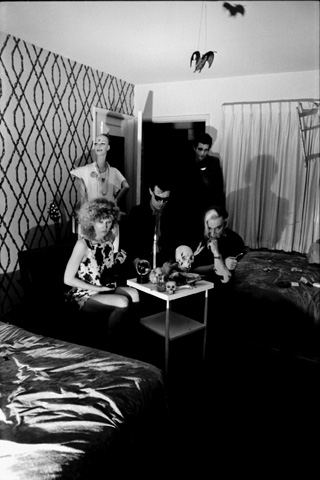You Just Can't Kill It

GOTH - you just can't kill it is the thesis of a comprehensive NYTimes piece on that subculture and fashion statement that has more lives than a cat operated by the Energizer Bunny. The tag line for the article reads: "Goth style endures, in high school and in high fashion, because alienation will always be chic."
Bags bassist, Patricia Morrison, pictured above, was a fashion forward progenitor of the style within her own punk rock peer group. Simultaneously, Siouxsie Sioux was donning similar severe make-up, and Patricia's future beau, Damned frontman, Dave Vanian was vamping it up in Vampyre style. Were these harbingers of high fashion alienated?

After the Dead Boys, Stiv Bators noticed that the so-called "New Romantic" genre was both fey in musical style as well as fashion sense, and he loved the idea of a man in frilly shirts and gypsy jewelry, so he adopted only the wardrobe, and stuck to his hard rocking roots when the Dead Boy turned Wanderer and later was knighted a Lord of the New Church.

The Cramps were always right on top of this vampire thing -- even though their influence grew out of B movies rather than literary classics.

While the fashion history research that the NY Times references cites Victorian England as the first time what we know as "Goth" fashion first emerged, actual goths - as in the tribe - date back to the 3rd or 4th century. They were people from what is now Scandinavia and Germany and nearby lands. The Goth history is rich in warfare and the Olde English and Norse folk tales reflect that.
Gothic ART was a Medieval art movement, including the International Gothic movement seen in Burgundy, Bohemia and Northern Italy in the 1300 and 1400s. Gothic ARCHITECTURE emerges some 400 years later, in the late 18th Century as a natural progression of Romanesque architecture that we mostly associate with the great cathedrals and abbeys from the Medieval period... the arches, ribbed vaults and most famously the flying buttresses. The layouts of these churches also reflect the form of the crucifix.
So - you see, as time passes on, Goth fashion accumulates these influences and you have people looking like vandals in mourning wearing fancy crosses... looking like Dracula or Nosferatu or Lilly Munster. Its all self expression - wearing it all on your sleeve.... and you just can't kill it.


Comments